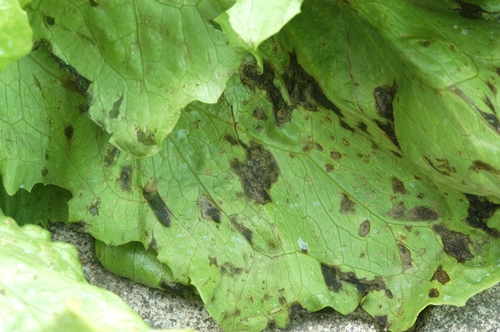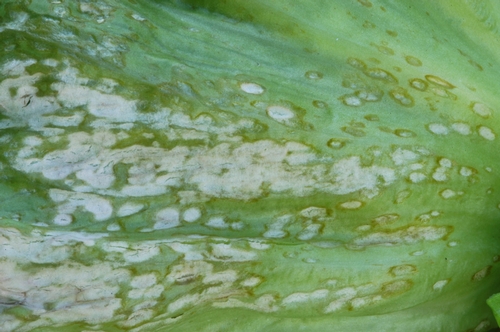Weather and lettuce diseases. Late spring rains, cold temperatures, and high humidity are making it possible for two important foliar diseases of lettuce to show up in California and cause damage in 2012. Both bacterial leaf spot and anthracnose have been observed in numerous fields throughout the central coast. If rains continue or if the crop is irrigated with sprinklers, both diseases can result in significant damage to lettuce leaves and resulting loss of yields due to poor quality of the harvested heads. Experienced field personnel will likely recognize these two problems without difficulty; however, we recommend that if there is any question, laboratory tests be conducted to confirm diagnosis.
Bacterial leaf spot. Initial symptoms are small (1/8 to 1/4 inch), water-soaked spots that occur on the older, outer leaves of the plant. Lesions are typically angular in shape and quickly turn black (photo 1)—this is the diagnostic feature of this disease and readily separates this from anthracnose (which causes white to light pink lesions). If disease is severe, numerous lesions may coalesce, resulting in the collapse of the leaf. Older lesions dry up and become papery in texture, but retain the black color. Lesions rarely occur on newly developing leaves.
Bacterial leaf spot is caused by bacterium Xanthomonas campestris pv. vitians. The pathogen is highly dependent on wet, cool conditions for infection and disease development. Splashing water from overhead irrigation and rain disperses the pathogen in the field and enables the pathogen to infect significant numbers of plants. The pathogen can be seedborne and is introduced into the field via contaminated seed. In addition, the bacterium can survive for up to five months in the soil. Therefore, infected lettuce crops, once disked into the soil, can supply bacterial inoculum that can infect a subsequent lettuce planting.
Spray applications are not effective at managing bacterial leaf spot of lettuce. The disease is managed by using uninfested seed, irrigating the crop via furrow or drip, and avoiding back-to-back lettuce rotations if the first crop was diseased.
Anthracnose. Early symptoms are small (1/8 to 1/4 inch), water-soaked spots occurring on outer leaves. Spots enlarge, turn yellow then tan, and are usually angular in shape. Under cool, rainy conditions, white to pink spore masses of the fungus will be visible in the centers of the tan colored lesions (photo 2)—this is the diagnostic feature of this disease and readily separates this from bacterial leaf spot (which causes black lesions). If disease is severe, the lesions will coalesce and cause significant dieback of the leaf and in some cases will result in stunting of the plant. As spots age, the affected tissue will dry up and become papery in texture. Eventually the centers of these spots can fall out, resulting in a shot hole appearance. Anthracnose lesions are often clustered along the midribs of lower leaves.
Anthracnose is caused by the fungus Microdochium panattonianum. This fungus infects only lettuce and does not cause disease on any other crop. The fungus can survive for up to four years as microsclerotia in soil. The anthracnose pathogen requires cool, wet conditions for infection and symptom development and hence is associated with rainy weather. Splashing water moves microsclerotia and conidia from soil onto leaves, resulting in infection.
To manage anthracnose, first avoid planting lettuce in fields having a history of the disease. Use irrigation systems (furrow or drip irrigation) that reduce or eliminate splashing water and leaf wetting. Apply protectant fungicides, such as strobilurins, which are effective for controlling this disease.

Photo 1. Bacterial leaf spot results in black, angular shaped lesions on lettuce leaves.

Photo 2. On lettuce, anthracnose results in tan, angular shaped lesions that are covered with the white to pink growth of the fungus.